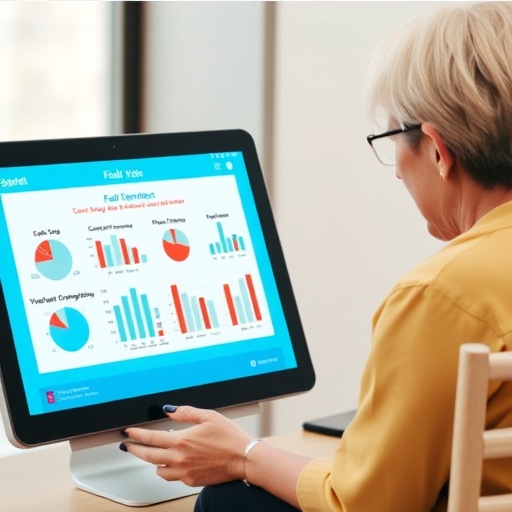In recent years, the increasing prevalence of falls among the aging population has attracted significant attention from healthcare practitioners and researchers. Falls lead to severe injuries, decreased mobility, and even premature mortality, creating a pressing need for effective assessments that can help identify individuals at high risk of falling. In a groundbreaking study titled “Evaluating a user-centered design driven multifactorial falls risk assessment tool in primary care,” researchers have implemented a novel tool aimed at mitigating fall risks in elderly patients. With the publication of their findings in the European Geriatric Medicine journal, the implications of their work resonate far beyond mere academic interest; the insights gleaned could shape future approaches to elder care on a global scale.
The study was carried out by a multidisciplinary team led by researchers Groos, Kuiper, and van Schoor, among others. Their focus was to develop a multifactorial falls risk assessment tool that not only identifies those at risk but is also user-friendly for both patients and healthcare providers. They recognized the importance of integrating practical usability alongside clinical accuracy and efficacy. The tool incorporates various risk factors, including physical health, environmental hazards, and psychological well-being, which makes it a comprehensive approach to falls prevention.
A significant highlight of the study is the user-centered design that was employed in its development. By involving end-users – in this case, elderly patients and their healthcare providers – in the design process, the researchers ensured that the tool would meet real-world needs and preferences. This collaborative approach greatly enhances the likelihood of acceptance and adherence to the recommendations derived from the assessment. As research suggests, user-friendly tools are more likely to be utilized effectively, which ultimately leads to better patient outcomes.
The randomized effectiveness-implementation study carried out by the researchers marks a significant advancement in falls management protocols within primary care settings. By comparing traditional risk assessment methods against their new tool, the team aimed to not only establish its effectiveness but also to assess how well it could be implemented in everyday healthcare practice. The findings indicated that the new assessment tool markedly improved the identification of fall risks in older patients, allowing for timely interventions that could prevent accidents before they occur.
Data from the trial indicated more than just an increase in awareness regarding fall risks; there was also a rise in appropriate preventive actions taken by healthcare professionals. The study outlines how the implementation of the tool has the potential to promote better communication among caregivers, patients, and family members regarding the steps needed to ensure safety. Importantly, such collaborative dialogues are essential in empowering older adults to be actively involved in their health and well-being.
Furthermore, the researchers not only concentrated on the efficacy of the tool but also delved into the perspectives of those using it. Through surveys and interviews, they gathered qualitative data that provided insights into users’ experiences. The feedback highlighted that the multifactorial approach allowed healthcare providers to tailor their interventions according to the unique needs of each patient, ultimately leading to higher satisfaction levels among both providers and patients. This balance of quantitative and qualitative data adds depth to the study, showcasing a holistic view of the tool’s impact.
The decision to focus on primary care for implementing the falls risk assessment tool reflects an understanding of where much of elder healthcare takes place. Many older adults visit their primary healthcare provider regularly, making this setting an ideal platform for launching preventive measures. The study underscores how effectively integrating this assessment into routine check-ups could save lives and reduce healthcare costs associated with fall-related injuries and hospitalizations.
In an era where healthcare systems are increasingly pursuing efficiency and patient-centered care, the findings from this study provide a viable pathway to achieve both. With elder populations projected to rise in the coming decades, the demand for such innovative solutions will continue to grow. This tool, as presented by the researchers, exemplifies a proactive strategy in responding to a global public health challenge, demonstrating that innovative thinking combined with established research can yield effective solutions.
Your standard falls risk assessment traditionally focuses on single dimensions of risk but often neglects the multifactorial nature of the issue. The innovative approach employed by the research team broadens the lens through which healthcare providers view falls risk. By incorporating elements such as mental health assessments and environmental evaluations, they set a new standard for comprehensive risk assessment. This multi-dimensional perspective is vital to the shaping of future preventative strategies that can truly address the complexity of fall risks among the elderly.
While the study presents compelling evidence in favor of the new tool, it also points to areas where further research is needed. Future inquiries could explore the long-term effects of implementing such assessments and how they might evolve with technological advancements, including the integration of smart home devices to proactively monitor fall risks. Additionally, expanding trials across diverse demographics and settings may yield valuable insights that could enhance the tool’s effectiveness and applicability.
Ultimately, the implementation of a user-centered multifactorial falls risk assessment tool could represent a paradigm shift in how elder care is approached. By prioritizing usability alongside clinical effectiveness, the researchers have laid the groundwork for transforming preventative healthcare strategies. The hope is that these insights will lead to widespread adoption of similar tools, enabling healthcare providers around the world to better protect their patients from falls.
As the expected publication date of the study approaches on November 4, 2025, the broader healthcare community awaits to see how these findings will influence current practices and the continuing evolution of elder care. This undertaking also reaffirms the importance of interdisciplinary collaboration in solving complex health issues that affect our aging population. It suggests that when innovative minds come together with the end-user in mind, the ultimate beneficiaries are the patients themselves.
As researchers and practitioners march forward into a future where proactive healthcare is the norm rather than the exception, the lessons learned from this study will undoubtedly resonate within the corridors of elder care facilities and medical practices alike. In tackling the issue of falls among the elderly, this innovative tool symbolizes not just a breakthrough in research but a testament to the potential for change when user-driven healthcare meets scientific inquiry.
In conclusion, the trailblazing research by Groos and colleagues underscores a fundamental truth in healthcare: meeting the needs of patients must be at the forefront of designing interventions. As the community gears up for the official release of the assessment tool, it is clear that the upcoming years hold significant promise for enhancing the health and safety of older adults everywhere.
Subject of Research: Multifactorial falls risk assessment tool in primary care
Article Title: Evaluating a user-centered design driven multifactorial falls risk assessment tool in primary care: a randomized effectiveness-implementation study
Article References:
Groos, S.S., Kuiper, J.I., van Schoor, N.M. et al. Evaluating a user-centered design driven multifactorial falls risk assessment tool in primary care: a randomized effectiveness-implementation study. Eur Geriatr Med (2025). https://doi.org/10.1007/s41999-025-01338-1
Image Credits: AI Generated
DOI: 04 November 2025
Keywords: Falls risk assessment, elderly care, user-centered design, primary care, multimodal healthcare, intervention strategies, patient safety.
Tags: comprehensive falls risk factorseffective fall risk identification methodselderly falls prevention strategiesfalls risk assessment toolimplications of falls in aging populationsimproving patient safety in primary careinnovative solutions for fall preventionintegrating physical and psychological health assessmentsmultidisciplinary approaches to elder careprimary care interventions for elderly patientsusability in healthcare toolsuser-centered design in healthcare





